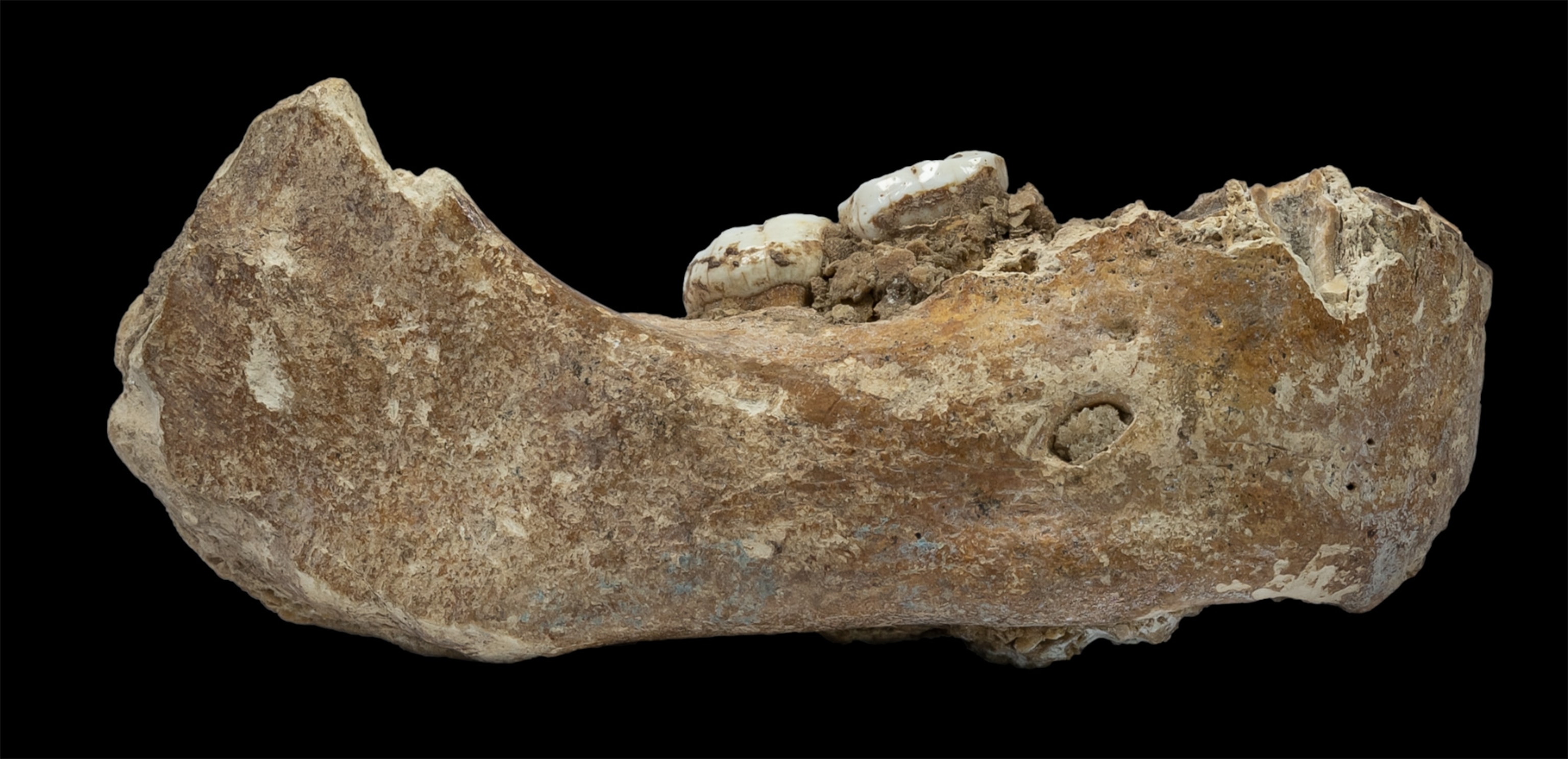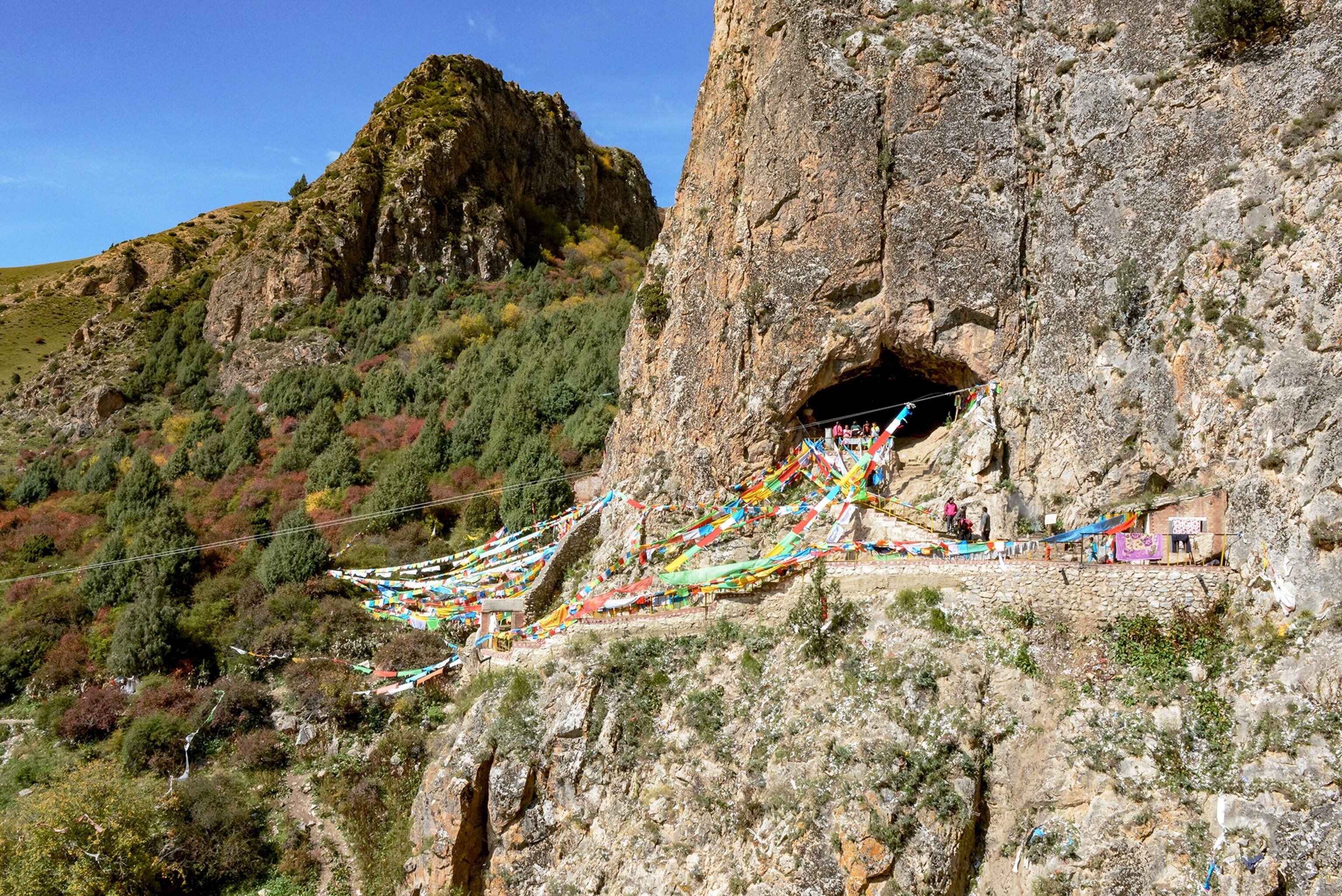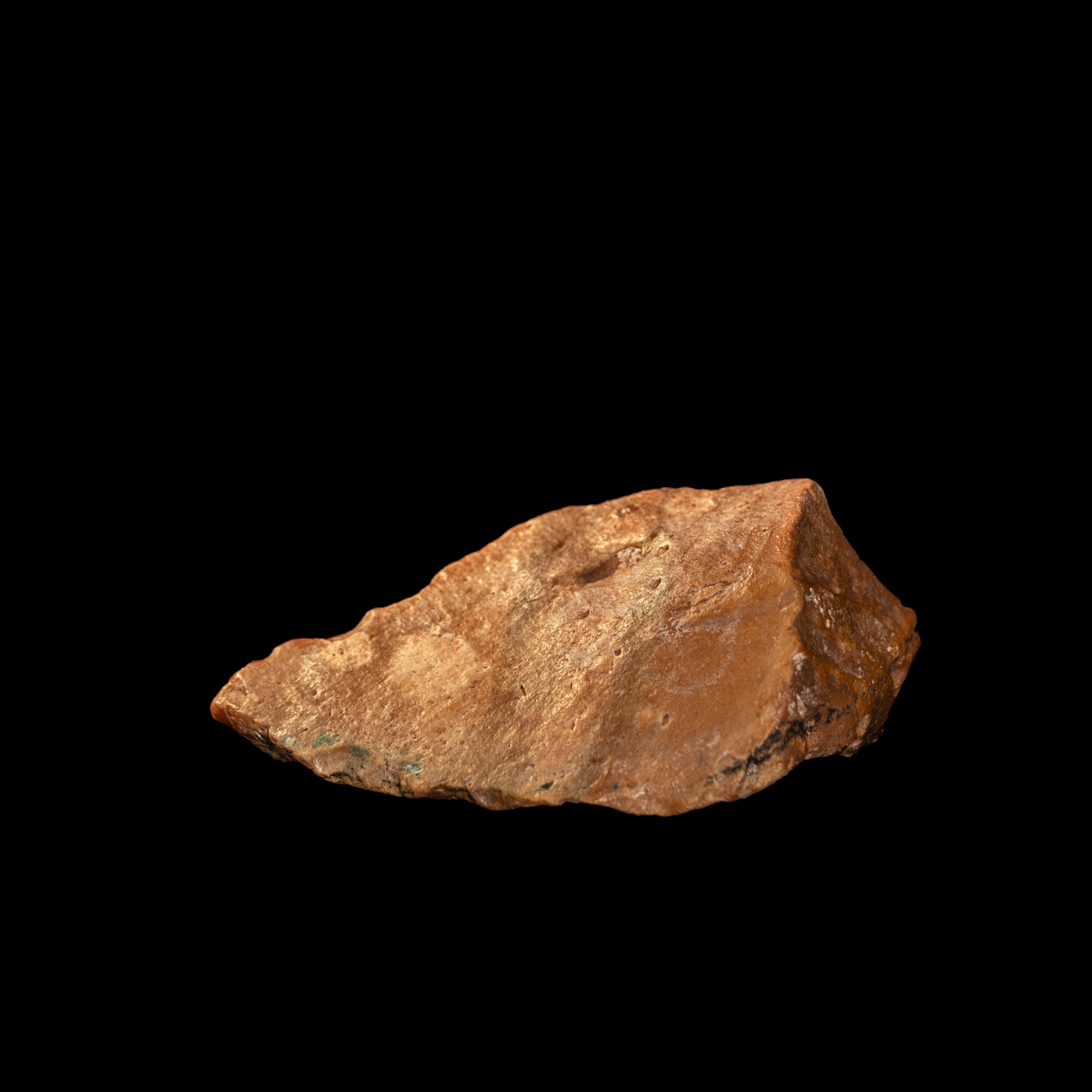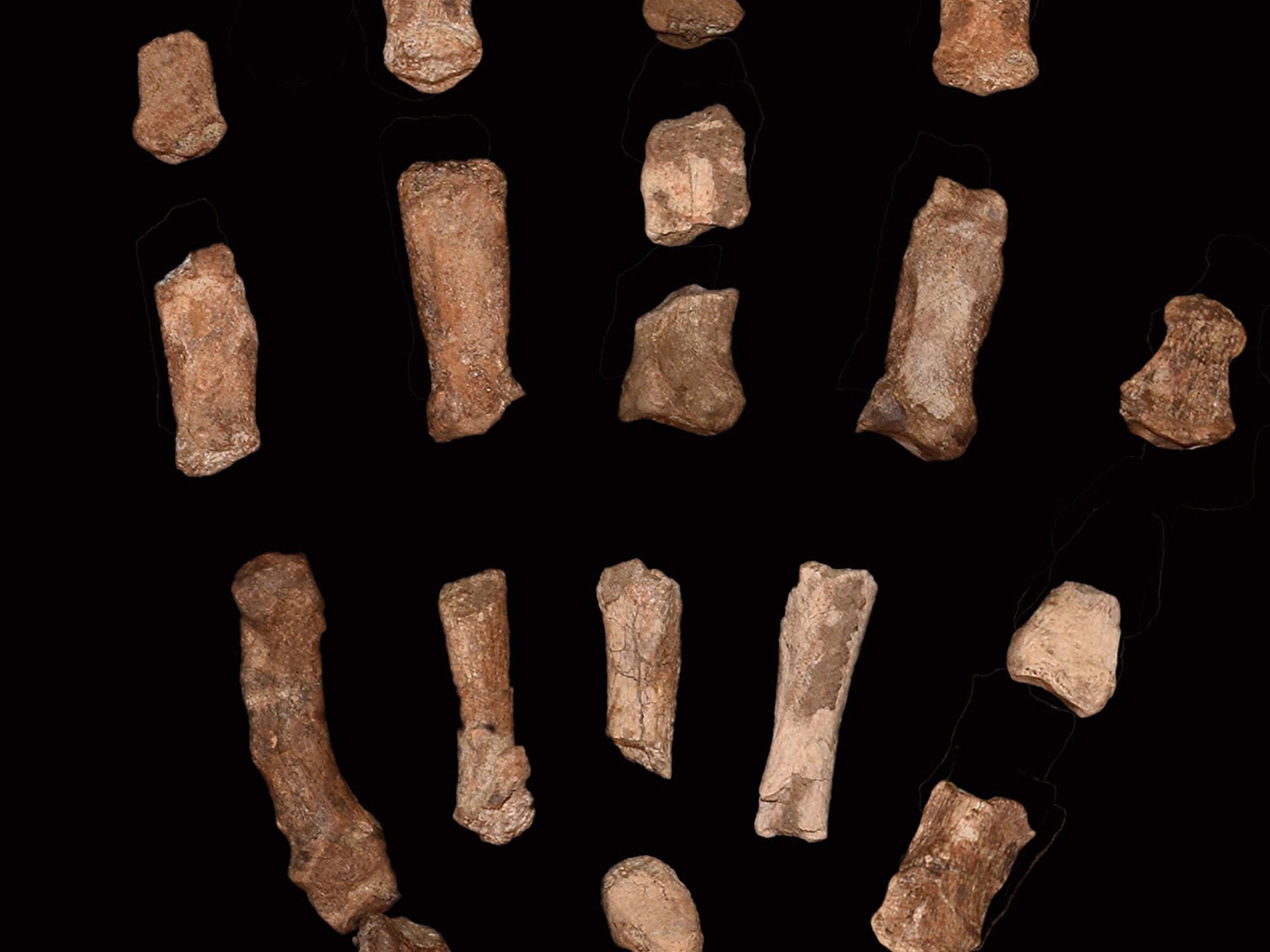The mouth of Baishiya Karst Cave nestles near the base of a towering crag at the edge of the Tibetan Plateau. Strands of colorful prayer flags crisscross the pale face of the hollow, a holy location where Tibetans have long retreated to pray and heal from sickness. Within the cave’s cool confines in 1980, a local monk happened on something unexpected: a jaw with two huge teeth that, while human, was definitely not like that of humans today.
A study published today in Nature reveals just how much this ancient jaw has to say. A detailed analysis of its physical features as well as proteins extracted from the fossil suggest that the mandible, dated to 160,000 years ago, comes from the enigmatic human population known as the Denisovans—a sister group to the Neanderthals previously identified from scant remains found in a single cave in Siberia's Altai Mountains.
“I just couldn't believe that at the moment [my colleagues] told me,” says study co-author Dongju Zhang of Lanzhou University, China. “I was really excited.”
Zhang’s excitement is justified: the jawbone, known as the Xiahe mandible after the county in China where it was found, fills a yawning gap in our understanding of this mysterious ancient. While the previous Denisovan fragments come only from the eponymous Denisova Cave in Siberia, people living all across Asia and Australasia today carry Denisovan DNA in their genomes. The discovery of the Xiahe jawbone at a locale over 1,400 miles away from this Siberian cave confirms Denisovans ventured much further across the continent.
It’s thought that after the Denisovans’ ancestors split from their Neanderthal relatives at least 400,000 years ago, they headed east into Asia, while early Neanderthals spread through Europe and western Asia. Modern humans first left Africa some 200,000 years ago, first as a trickle and then in waves. Eventually they encountered and interbred with Neanderthals in the Middle East. Those who trekked east into Asia likewise mated with the resident Denisovans, who left genetic fingerprints still present in Asians today.
One such Denisovan fingerprint helps modern Sherpas and Tibetans adapt to the thin air on the roof of the world. But until now, evidence of Denisovans was found only at a relatively low altitude: Denisova Cave is just 2,300 feet above sea level. The Xiahe jaw, found at roughly 10,760 feet, is the first physical evidence that Denisovans ventured up into the same altitudes as living humans carrying the genetic adaptation to low oxygen environments. And at 160,000 years old, the jawbone is four times the age of the earliest evidence of human activity in the Tibetan Plateau’s challenging climes, underscoring the remarkable resilience of our ancient relatives.
“Thanks to this study we are 'cornering' Denisovans,” says María Martinón-Torres, the director of Spain's National Research Center on Human Evolution, via email. “Their portrait is progressively less blurred.”
The monk and the jaw
While the jaw was discovered back in the 80s, researchers only began studying it three decades later. In 2010, Lanzhou University's Zhang, her newly minted Ph.D. in hand, turned to the strange hominin remains on the urging of her graduate advisor Fahu Chen, who led the recent study, and colleague Guangrong Dong also of Lanzhou University.
First up was figuring out where the mandible had actually been found. The anonymous monk who happened upon the odd bone passed it along to the sixth Gung-Thang Living Buddha, an eminent figure thought to be reincarnated from past individuals who held the title. But the monk neglected to mention the name of the cave where he’d come across the fossil.
The team whittled the possibilities down to just one: Xiahe county’s Baishiya Karst cave, whose name translates to “white cliff” in Chinese. Excavations in the cave subsequently revealed large animal bones with cut marks and stone tools. Research on these artifacts is ongoing, Zhang says, so she can't yet say whether the Denisovan group represented by the fossil actually made the tools or left their marks in the faunal remains.
“It takes us step by step a long time,” Zhang says of the project.
Analysis of the jaw itself turned up even more surprises. Its morphology suggests it is neither Homo erectus nor Homo sapiens, whose remains are widespread across mainland Asia. The shape of its row of teeth, for instance, was not elongated, as they are in H. erectus. And the jaw lacks a chin—a unique trait of modern humans. Most telling of all was the sheer size of the teeth, which are similar to those from Denisova Cave bearing Denisovan DNA.
“To me it hits the expected morphology really well,” says paleoanthropologist Bence Viola of the University of Toronto, who is an expert on Denisovan fossil morphology. “It really looks like what one would have hoped for.”
For confirmation, the researchers first attempted to extract DNA from the fossil jaw. When the analysis revealed that the ancient DNA had degraded, they turned to a more durable, if less sensitive, molecular tool: the proteins built from DNA codes.
The researchers extracted proteins from both the jawbone and the tooth dentine. They then used an enzyme to cut the proteins into short strands to identify the amino acid building blocks encoded by DNA. Overall, the dentine proteins appeared much closer to the Altai Denisovans than to Neanderthals or modern humans, says Frido Welker of the University of Copenhagen, who specializes in ancient hominin proteins and led this phase of the work.
“I love the way cutting-edge techniques have been put together to make the dead speak,” says Martinón-Torres, who was not involved in the work. “Paleo-genetics was a revolution in the paleoanthropological field and now proteomics constitutes another frontier [of] research, opening a door to unforeseen dimensions of knowledge.”
Chasing the Denisovan ghosts
There are, however, limits to what can be said from proteins. Denisovans had a stunning amount of diversity. A study published earlier this year suggested that what we call Denisovans might actually be three distinct genetic lines, one of which is nearly as different from other Denisovans as they are from Neanderthals. But the similarity of proteins across groups and through generations makes it difficult to pinpoint precisely how similar the owner of the jaw is to these three Denisovan lines—or if it was from yet another sister group.
“This mandible, one way or another, will fit into this story,” Welker says.

The tantalizing connection the jaw makes between what was once thought of as a low altitude group of humans and their mysterious role in modern high-altitude adaptations also remains fuzzy, explains Emilia Huerta-Sanchez, a population geneticist at Brown University and lead author of the 2014 Nature study that first identified this genetic link.
“I agree with the authors that it could be that this hominin group was high altitude adapted,” she says. “But I don’t think we know for certain.”
Huerta-Sanchez explains that the genetic tweaks thought to help modern Tibetans thrive in low-oxygen environments are not part of a sequence that codes for proteins, but instead control how much of a particular protein is made. While the jaw was found where oxygen levels are low, without the DNA itself, scientists can't be sure the jaw’s owner carried the adaptation to survive in that thin air.
“I want that to be true though,” Huerta-Sanchez says, her voice wistful.
Future Denisovan drama
While there are still many unknowns, scientists are excited about what other clues the jaw may hold for understanding human evolution in Asia. The fossil could for instance be used to identify other Denisovans from the growing pool of hominin fossils in Asia that don't neatly fit into the known branches of our increasingly bushy family tree, says Martinón-Torres, who has extensively studied the Asian fossil record. For example, a three-rooted molar in the jaw is similar to that of a tooth in a previously described mandible known as Penghu 1, hinting that it, too, may be a Denisovan.

The study has also piqued other researchers' curiosity about what else may be hiding at elevation. “The high mountains of Asia are really, really unknown,” Viola says. “People usually just assumed nobody lived there.”
Viola studies one of the other few high-altitude hominin sites yet identified, the Sel’ungur Cave in Kyrgyzstan, which is just over 6,200 feet high. He and his collaborators always presumed the cave's remains belonged to Neanderthals, but this new study has his mind churning.
“Maybe they were Denisovans,” he wonders.








